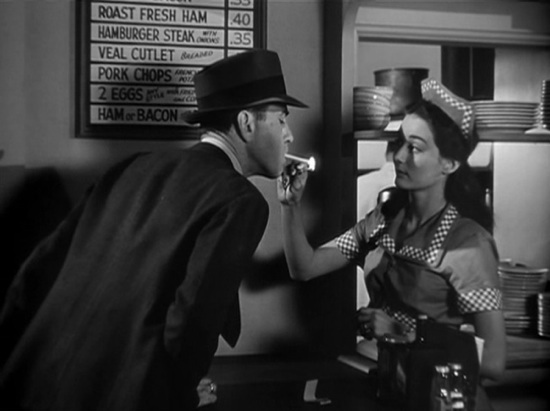Shocking Blocking (10)
By:
December 31, 2010

The protagonist of hardboiled fiction is intimate not only with transgressors (inhuman criminals, the inhuman rich) but with the inhumans’ human victims. So how to avoid being victimized without becoming inhuman oneself? Doing so requires resolve, a virtue vulnerable to the sentimentality virus. The hardboiled protagonist has developed a sentimentality-proof exoskeleton; he’s become an arthropod. Arthropodization (cf. Philip K. Dick’s “androidization”) is a theme of some of Hardboiled Generation director Howard Hawks’s best movies. In the scene from The Big Sleep shown here, a diner waitress is drawn to yet repulsed by Marlowe (Humphrey Bogart): she turns on a light, he scuttles into the shadows; he asks her for a light, she leans towards him avidly — yet with a raised eyebrow. As in Bogart’s scenes with a gal taxi driver, a bottle-blonde librarian, and a nightclub cigarette girl, Hawks’s blocking — the director chivalrously places barriers between the arthropod Marlowe and the human dames — illustrates the hardboiled condition, in which immunity from the inhumans’ allure is purchased at the cost of human contact. The women whom Hawks doesn’t barricade from Marlowe are not potential victims: Agnes (Sonia Darrin) and Mona Mars (Peggy Knudsen) are criminals, Vivian Sternwood (Lauren Bacall) is rich, while Carmen Sternwood (Martha Vickers) is a rich criminal. The proprietress of the Acme Book Shop (Dorothy Malone), meanwhile, is something else altogether.
An occasional series analyzing some of the author’s favorite moments in the positioning or movement of actors in a movie.
THIRTIES (1934–1943): It Happened One Night (1934) | The Man Who Knew Too Much (1934) | The Guv’nor (1935) | The 39 Steps (1935) | Young and Innocent (1937) | The Lady Vanishes (1938) | Mr. Smith Goes to Washington (1939) | The Big Sleep (1939) | The Little Princess (1939) | Gone With the Wind (1939) | His Girl Friday (1940)
FORTIES (1944–1953): The Diary of a Chambermaid (1946) | The Asphalt Jungle (1950) | The African Queen (1951)
FIFTIES (1954–1963): A Bucket of Blood (1959) | Beach Party (1963)
SIXTIES (1964–1973): For Those Who Think Young (1964) | Thunderball (1965) | Clambake (1967) | Bonnie and Clyde (1967) | Madigan (1968) | Wild in the Streets (1968) | Barbarella (1968) | Harold and Maude (1971) | The Mack (1973) | The Long Goodbye (1973)
SEVENTIES (1974–1983): Les Valseuses (1974) | Eraserhead (1976) | The Bad News Bears (1976) | Breaking Away (1979) | Rock’n’Roll High School (1979) | Escape from Alcatraz (1979) | Apocalypse Now (1979) | Caddyshack (1980) | Stripes (1981) | Blade Runner (1982) | Tender Mercies (1983) | Monty Python’s The Meaning of Life (1983)
EIGHTIES (1984–1993): Repo Man (1984) | Buckaroo Banzai (1984) | Raising Arizona (1987) | RoboCop (1987) | Goodfellas (1990) | Candyman (1992) | Dazed and Confused (1993) |
NINETIES (1994–2003): Pulp Fiction (1994) | The Fifth Element (1997)
OUGHTS (2004–13): Nacho Libre (2006) | District 9 (2009)
READ MORE essays by Joshua Glenn, originally published in: THE BAFFLER | BOSTON GLOBE IDEAS | BRAINIAC | CABINET | FEED | HERMENAUT | HILOBROW | HILOBROW: GENERATIONS | HILOBROW: RADIUM AGE SCIENCE FICTION | HILOBROW: SHOCKING BLOCKING | THE IDLER | IO9 | N+1 | NEW YORK TIMES BOOK REVIEW | SEMIONAUT | SLATE
Joshua Glenn’s books include UNBORED: THE ESSENTIAL FIELD GUIDE TO SERIOUS FUN (with Elizabeth Foy Larsen); and SIGNIFICANT OBJECTS: 100 EXTRAORDINARY STORIES ABOUT ORDINARY THINGS (with Rob Walker).
